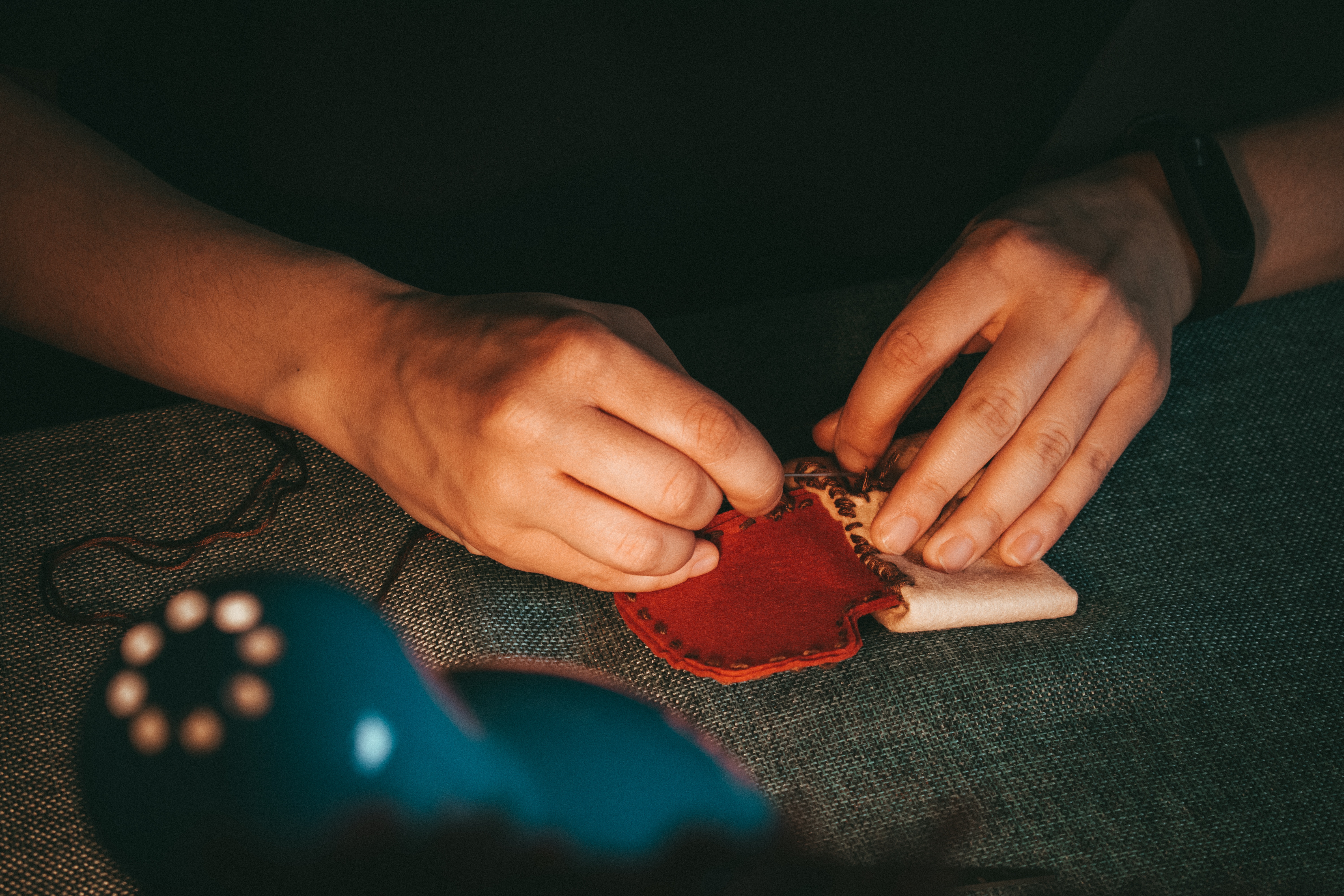
I have slowly started to explore the world of upcycling — where I take a piece of furniture that has seen better days and breathe new life into it. I’ve used tools I’ve never used before like a power washer that basically strips even the toughest stains and a power sander to smooth out the wood, prepping for priming and painting. I am not artistic or creative when it comes to carpentry or any sort of woodwork but I have fallen in love with the process. For my husband, it’s the same with gardening. There is something so soothing about just focusing on the task and the rhythmic nature of working with one’s hands. It is meditative and at the end of the day we feel calmer, happier, and at the same time, excited about the next step. Don’t get me wrong, it is tiring. We are moving, using physical strength but perhaps more than that, we are concentrating, using mental strength. But it doesn’t feel exhausting. And the reward isn’t the end product (although the sense of achievement is quite satisfying). The reward for us is getting lost in a moment where the only thing we think about is what is in front of us.

Perhaps it is the uncomplicated nature of the process. There is a solution to any situation and there is a predictive path towards achieving the desired effect. There is room to be unconventional but the nuts and bolts of it are mostly the same. And in life, where complications arise, it is nice to have that ability to work through something, or feel we have control over it. That if we did A it will lead us to B. The American actor Nick Offerman, known for his roles in tv series like Parks and Recreation and Curb Your Enthusiasm has talked and written about how woodworking helped him in his professional work as an entertainer, how it offered him the space to think and create — away from the demands of an ever-demanding, and ever-judgemental industry. He says, “I would see the tangible result of this work that I had done. The thing is, there’s no way to describe the sensation. There’s magic in it, whether you’re working with glass or metals or food or knitting or wood.” Offerman would go on to say the “powerful and empowering sensation” coupled with having a “meditative or Zen” effect on him gave him the ability to look at things differently, in a calmer, clearer manner. It gave him perspective.

Scientists and psychologists have long recognised that the brain isn’t the only force at work when it comes to our cognitive abilities and our thought processes. I say long but actually it was only in the early 20th century did the idea of “embodied cognition” take root. As the publication Scientific Americanputs it, “embodied cognition (is) the idea that the mind is not only connected to the body but that the body influences the mind.” There are various interpretations of embodied cognition and studies have reflected the numerous angles with which neuropsychologists have looked at it but for purposes of this article, I have found that there are professors, like Tony Chemero — professor of philosophy and psychology at the University of Cincinnati, who do believe that embodied cognition is an important understanding of how we can get ourselves out our own heads, and in essence out of our own way, by doing something that involves physical movement. Professor Chemero says, “Thinking isn’t something that just happens to your brain, it’s an activity you engage in and you have to move to engage with it a lot of the time.” It’s why doctors and therapists say physical exercise is key to keeping us mentally and emotionally healthy. For me, what I find fascinating is the use of our hands, and how that transforms my mental state into being calm and content. In the journal Cognitive Science, Susan Goldin-Meadow, professor of psychology at the University of Chicago said, “We change our minds by moving our hands.”

We live in a busy world, most of us are rushing around in our own bubbles trying to get through the day, accomplishing what we feel we need to accomplish. Oftentimes, we move through our days in a predictive manner, so much so that we don’t really need to think about it. It becomes second nature to us. Until it doesn’t. Until we get caught in that proverbial rut and feel we aren’t moving at all, emotionally and mentally. That rut can be difficult to get out of if we solely rely on our minds to help us. It’s all well and good for us to be told to “put our minds to it” or to have the willpower to push through our mental blockages. But when we are burnt out or drained, the same solutions we would have applied during our “better” days won’t necessarily work on us now. Sometimes, logic isn’t always right. And in fact, our brains are wired to keep us in our habitual patterns. Dr. Srini Pillay, author of Tinker Dabble Doodle Try: Unlock the Power of the Unfocused Mind writes, “We become stuck in ruts due to our brains’ habitual electrical patterns. Past experience shapes present and future behavior. Faced with new situations, our brains will apply rules based on prior events to match the current context. And there’s a part of the brain that is especially wired to do this. Called the dorsolateral prefrontal cortex (DLPFC) — think of it as the brain’s “pattern seeker” — this brain region works hard to find old rules that can be applied to the here and now to circumvent the chore of new learning.” Dr. Pillay says that in order to block the “pattern seeker” we have to stop what we’ve been doing and unfocus. Because, on the flip side, the brain craves change. We see it when we do something different after concentrating hard on one thing. When we put our mind to something else, we feel lighter and refreshed. Sometimes we need to go back to basics and just move, put one step in front of the other and go for a walk. For me, it takes shifting focus onto something completely unrelated to my regular life patterns in order to get me out of any slump and help refresh my mind. And for me, it is working with my hands.

It is perhaps artists who demonstrate this well. Rod Junkins, artist and author, wrote, “An artist doesn’t draw and then think, he draws and thinks at the same time. That is why their ideas have such power. If you want to formulate new ideas, think with your hands. Make something as you reflect.” And it is with the use of our hands to create that we are teaching ourselves the tools we need to help us through life’s challenges. Art therapist Lisa Mitchell says, “art + therapy both rely on the same creative process: a process of finding unexpected solutions, shifting perceptions, and transforming “mistakes” into masterpieces.” She writes, “We learn that imperfections lead to improvements. We learn to tolerate failing for the sake of improvement, and we learn to dare to fail in the name of discovering new techniques. Keeping in touch with our creative process, the process through which our hands must engage when creating, makes us resilient.” And, Mitchell says, it isn’t only artistic for us to use our hands to find meaning in our life, it is evolutionary saying, “Our hands activate a surprisingly large part of our brain. The brain real estate our hand activity occupies is disproportionate in size — it’s larger than what our legs or back require. It’s pretty amazing– using your thumb requires more cortical activity than moving your back.”

I am not one to sit and meditate. I have tried but I just get jittery. Yet every time I knit, sew, dig, and now refurbish, I feel happy and in the moment. I am fully engaged with the here and now. Isn’t that what meditation is? When other thoughts and worries creep up (because I am human and that’s what we do), I don’t become anxious because through working with my hands, I go back to the rhythm of movement. In turn, I feel positive and know that I will find a solution to my problems. Isn’t that meditation? Allowing thoughts to come and go and just be present?
The emotional high of completing a task is great. It is a reward our brains recognise. A reward any of us who suffer or have suffered from depression will see as life changing. And while the rewards may get us to keep referring back to the activity as an outlet for us, it is the movements of working with our hands, the repetition, that is the real game changer. Neuroscientist Dr. Kelly Lambert, author of Lifting Depression: A Neuroscientist’s Hands-On Approach To Activating Your Brain’s Healing Power wrote, that the physical activity of using our hands changes “the neurochemistry of our brain in ways that a drug can change the neurochemistry of our brain.” For some, the that change can be achieved simply by doing dishes or folding laundry. For me, as I found, it is focusing on the creative side of using my hands — the movement that comes with that. Carl Jung, the psychiatrist and founder of analytical psychology once said, “Often the hands will solve a mystery that the intellect has struggled with in vain.” For me it is that mystery, it is getting lost in a moment that, I believe, helps me find myself.


